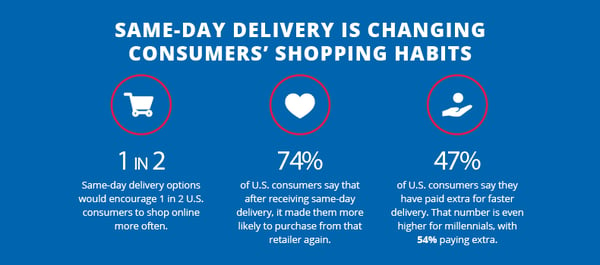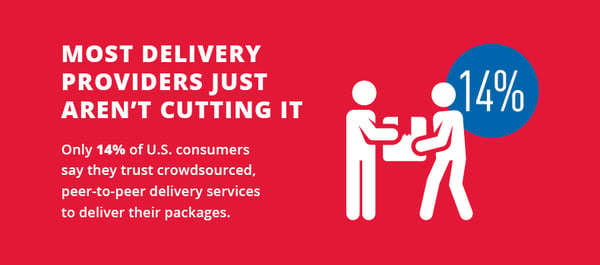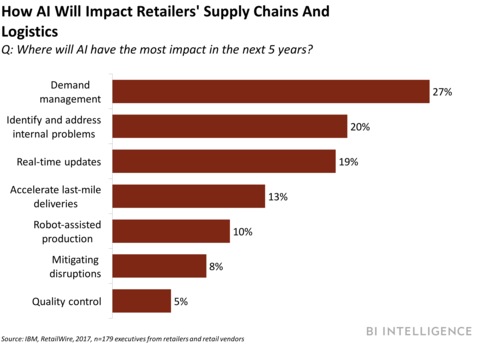How to Improve e-Commerce Customer Retention With Improved Delivery and Product Logistics?

Whether your outdoor brand uses it owns logistics and transportation systems or you use a third party service for them, you should be pressing to for the adoption of AI tools to improve execution and efficiency in delivery while paying attention to what customers really want out of the delivery experience.
Expectations of Improved Customer Experience is Affecting Customer Satisfaction and Retention
Infor discovered that 78 percent want to receive order updates on items they’ve purchased online. In a world where Uber Eats displays virtually every step of your food’s journey from store to door, customers increasingly expect such visibility whenever they purchase anything online. It starts with having a superior e-Commerce platform that uses AI and continues on with the use of AI in the logistics and transportation segment of the purchase (check out our Complete Guide to e-Commerce Services for Outdoor Products).
That could be why nearly half (49 percent) of the 78 percent referenced above said they most want to know their order’s ETA (estimated time of arrival), which can be useful in helping to set expectations and empower consumers to most effectively plan their time. Another 29 percent expressed interest in accessing real-time information on where their order is, perhaps again a result of the “Uber” effect. And now Uber and others like it are becoming a piece of the "last mile of delivery."

According to Dropoff's annual survey, consumers:
- Expectations around delivery are rapidly increasing, yet their delivery experiences are declining.
- An astonishing 99% of U.S. consumers say ‘fast delivery’ is important to them when making online purchases.
- Only 14% of consumers trust peer-to-peer delivery services.
- 74% of consumers say they’re more likely to purchase again from a company after receiving same-day delivery on an item.
- 74% of consumers say they’re more likely to purchase again from a company after receiving same-day delivery on an item.
- 88% of consumers say the ability to track shipments in real-time is important.
- 75% of consumers agree that the professionalism of the delivery person is important.
Outdoor brands who have their own e-Commerce services for outdoor products or speciality stores that offer delivery need to understand that the opportunity in this "last mile" of their product's journey to the customer is a tremendous opportunity to increase customer loyalty and repeat purchases. The individuals you entrust your product to for delivery directly reflects on you. They have a tremendous responsibility in leaving a good impression.

A decade or more ago it was rarer to have a package delivered to our front door by anyone other than the humble postman. But, since the advent of Amazon and other online shopping platforms, the profile of the world of logistics has been raised significantly as logistic agents knock at our doors.
Like in many other industries, Artificial Intelligence (AI) has been leveraged to optimize the logistics sector. BonVision Technologyfor instance, helps its clients by utilizing sophisticated AI rules to allocate available resources to process containers which are being conveyed by cargo aircraft. Factors such as priority of the package and type of goods, as well as flight and pick-up schedules, are all drawn upon to enable AI to make the best possible decisions.
Others have affixed AI into cloud services to deliver previously unseen efficiencies in the complex and fragmented market of logistics suppliers and customers. Rather than replacing humans, AI tools serve to make employees more efficient, allowing decades of experience located in a handful of team members to be utilized by a much larger pool of people due to the democratization and improved accessibility of information.
Use of AI Tools is Delivering an Increased Profit to Early Adopters
AI’s ability to streamline so many supply chain and logistics functions is already delivering a competitive advantage for early adopters (Amazon in particular) by cutting shipping times and costs. Reported in Business Intelligence, "a cross-industry study on AI adoption conducted in early 2017 by McKinsey found that early adopters with a proactive AI strategy in the transportation and logistics sector enjoyed profit margins greater than 5%. Meanwhile, respondents in the sector that had not adopted AI were in the red."
However, these crucial benefits have yet to drive widespread adoption. Only 21% of the transportation and logistics firms in McKinsey’s survey had moved beyond the initial testing phase to deploy AI solutions at scale or in a core part of their business.
In this same vein, customer expectations for an enhanced experience during the period after purchase and arrival at their location is increasing. The tools industry needs to deliver this experience and meet consumer expectations will be driven by the use of AI in those parts of the logistics and transportation chain affecting this time period.

This Amazon effect is changing things both big and small. AI tools are being deployed to improve logistics and transportation in the areas of planning, inventory management and forecasting, decision making, optimization, pattern recognition, and pattern recognition of factors affecting delivery.
A decade or more ago it was rarer to have a package delivered to our front door by anyone other than the humble postman. But, since the advent of Amazon and other online shopping platforms, the profile of the world of logistics has been raised significantly as logistic agents knock at our doors.
Like in many other industries, Artificial Intelligence (AI) has been leveraged to optimize the logistics sector. BonVision Technology for instance, helps its clients by utilizing sophisticated AI rules to allocate available resources to process containers which are being conveyed by cargo aircraft. Factors such as priority of the package and type of goods, as well as flight and pick-up schedules, are all drawn upon to enable AI to make the best possible decisions.
Others have affixed AI into cloud services to deliver previously unseen efficiencies in the complex and fragmented market of logistics suppliers and customers. The transportation company C.H. Robinson functions as a “freight broker”, pairing those who wish to ship with those that can deliver. AI helps with everything from price prediction to securing and managing the inventory of trucks available to transport loads. Leveraging years of professional expertise in pricing, deliveries and overcoming disruptions, the AI has learnt how humans tackle these challenges and attempts to apply that knowledge.
Rather than replacing humans, the AI tool has served to make employees more efficient, allowing decades of experience located in a handful of team members to be utilized by a much larger pool of people due to the democratization and improved accessibility of information.
It used to be that transportation and logistics were focused on cost, cost, cost. But Amazon really changed that basic premise when it pushed "shipping costs" into the category of table stakes. Although cost for many consumers is still important, consumers care and demand speed, agility and transparency in the delivery of their purchases. A brand's supply chain logistics and transportation must not only be efficient and less costly, it must be there to serve the end customer from the beginning. The end of any discussion regarding how to improve the customer experience in the period between purchase and delivery to them must begin with how are we or are third party providers getting it to them in a customized way that meets their expectation and increases customer retention.

